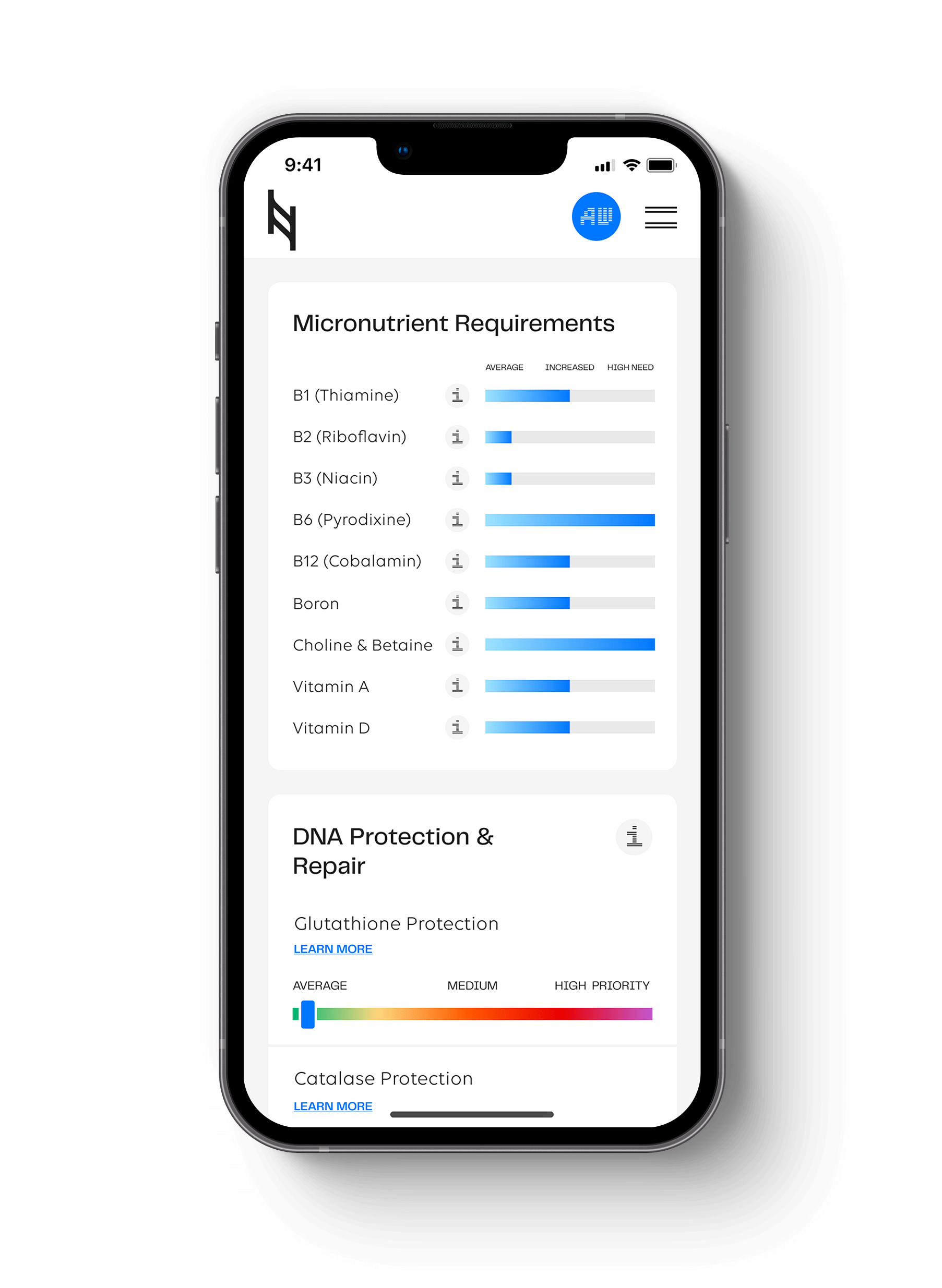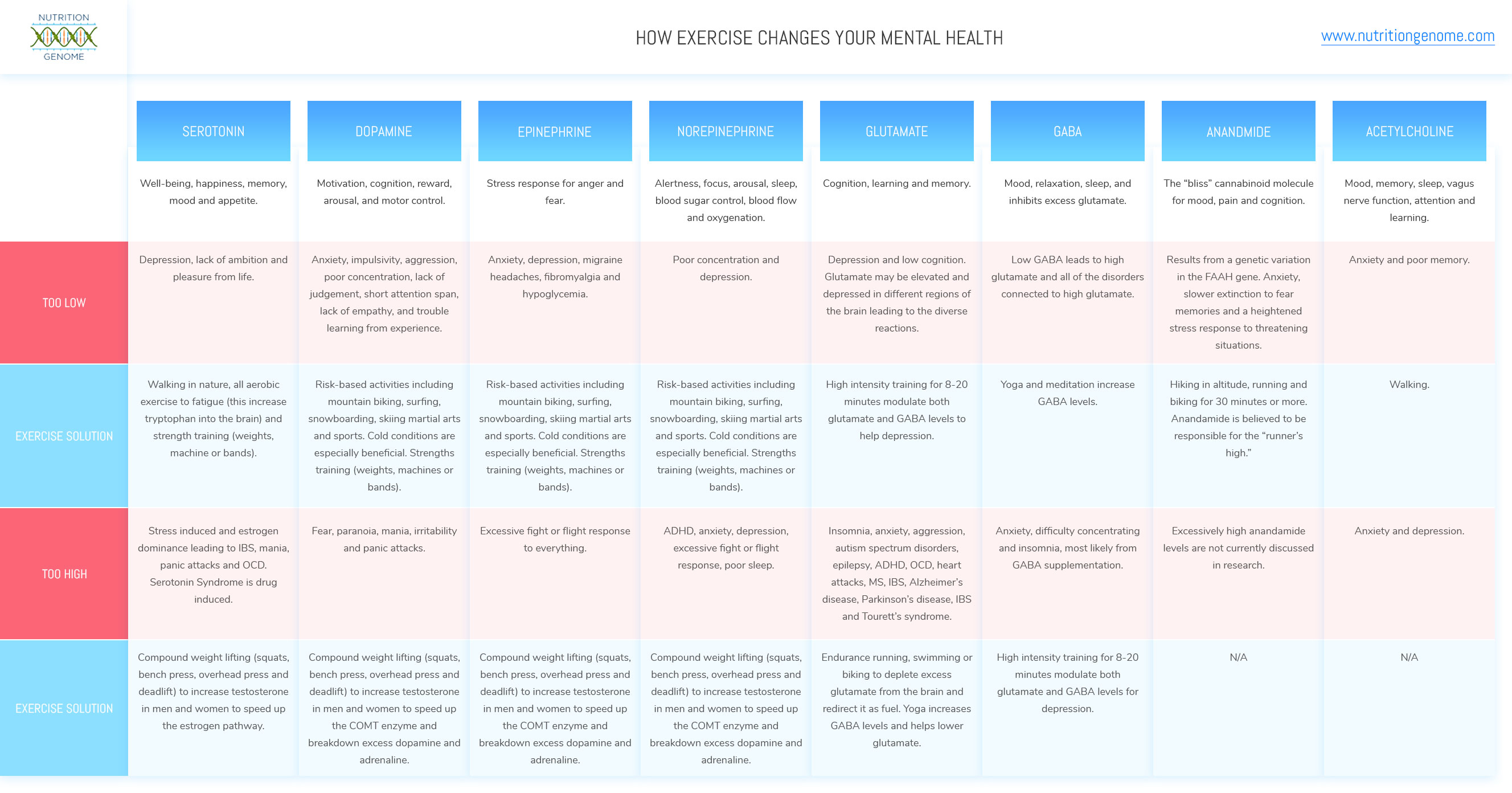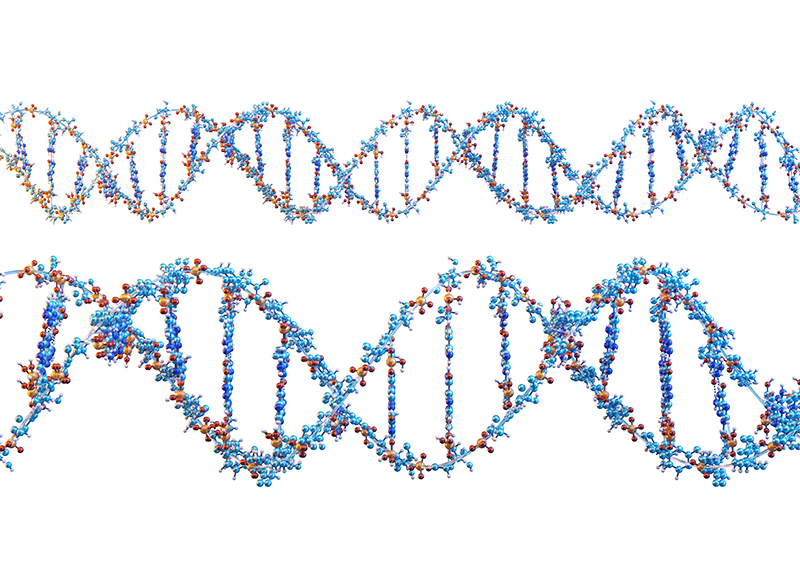Have you ever wondered why you are attracted to certain types of exercise? Do you need a thrill through risk-taking activities? Competitive sports or races? A solo trek on a trail or in the weight room? Do you feel your best with endurance exercise like running, swimming and biking? When you get stressed, do you have a physical outlet? The best exercises for mental health actually have a genetic basis, with genetic testing helping you develop a custom workout routine.
Perhaps one aspect of this attraction is a proclivity to certain activities based on your natural ability. If you are good at something, you are more likely to be consistent with it and enjoy it. However, there is another aspect that is more physiologically unconscious. Our brain may be directing us through a “craving” for certain activities to balance our neurotransmitters.
For some people, there is an intuitive ability to find a healthy, physical, epigenetic outlet to balance their minds. Others may fall victim to abusing drugs and alcohol. The key is learning how your individual brain works so that if you are not applying these principals intuitively, you can learn how to incorporate the right type of exercise to balance your brain.
Quick Facts on Mental Health
- According to the World Health Organization, between 1990 and 2013, the number of people suffering from depression and/or anxiety increased by nearly 50%, from 416 million to 615 million.
- Depression is the major cause of suicide. Looking at 300 million who suffered from depression, an estimated 100 million did not respond to anti-depressant therapy.
- Drug overdoses have become the leading cause of death for those in America under 50, and there has been a burgeoning interest regarding homicidal behavior and suicides of those on prescription psychiatric drugs. Synthetic opioids (both prescription and black market) represent 67.8% of all overdose deaths as of 2017.
Why Some Antidepressants Fail
It is paramount to understand that the single neurotransmitter imbalance theory is often inaccurate as the imbalances often occur through multiple pathways. Someone suffering from anxiety and depression can stem from a combination of serotonin, dopamine/adrenaline, acetylcholine, anandamide or glutamate/GABA imbalances. This is why you will see someone not respond to a medication that targets only serotonin like SSRI’s, then respond favorably when a second medication like Lamictal is added to balance glutamate.
The genetic blueprint of each person will show a diversity of neurochemical reactions from stress-induced anxiety and point in the direction where certain “triggers” can manifest. If we approach each case of anxiety or depression with the same solution, a significant percentage of attempts will fail.
There is also the concern of side effects (short and long-term) and ineffectiveness of prescription medications, and abuse, as seen with the opioid epidemic. SSRI’s do not increase serotonin production but work by tricking the brain into thinking that there more serotonin than there actually is. The problem is that over time this can actually lead to serotonin depletion and further depression.
Exercise and Opioid Release
Many of the genes (OPRM1 is the opioid receptor gene) that are thought to play a role in opioid addiction are involved in the endogenous opioid system for regulating pain, reward, and addictive behaviors. We need to look at why so many people are in chronic pain, lack pleasure in their lives and are reaching towards opioids for relief.
As a whole, there is a consensus that exercise is beneficial for anxiety and depression. While it has been discussed what types of exercise best target certain muscle groups and aesthetic results, less attention has been paid to how each type of exercise affects our neurotransmitters and opioid system.
Exercise releases endorphins similar to opioids, interact with opioid receptors and diminish the perception of pain. In fact, the greater the discomfort and struggle experienced during exercise, the greater the endorphin high afterward. The endocannabinoid anandamide, known as the “bliss” molecule responsible for the “runner’s high,” along with endorphins, also reduces pain. A sedentary lifestyle and void being filled by synthetic opioids instead of exercise should not be overlooked.
If we are to successfully reverse the statistics on depression and anxiety, we must illuminate one of the most powerful mental health prescriptions available to everyone on the planet: targeted exercise.
The Best Exercises for Mental Health Based on Neurotransmitters and Hormone Levels
While the motivation for exercise can be difficult for those with depression, the gradual incorporation of the right exercise with easy to obtain goals in the beginning that you can build upon will eventually increase the desire to produce the feeling you get each time. Just like with drugs targeting the wrong neurotransmitters, you wouldn’t spend all your time on bicep curls if you want stronger legs. If running or going to the gym makes someone feel miserable, this isn’t a failure of the individual, it is the failure of the approach.
A general recommendation of exercise falls flat just like broad dietary recommendations. We have to think of exercise as we do with nutrigenomics; each person is unique and has specific requirements to yield the most efficient and effective results.
This diagram represents how low and high levels of neurotransmitters can make you feel. This can help identify where the primary issues may be occurring. Under each “low” and “high” of each neurotransmitter, you will see what the published research has found with each type of exercise and how it influences individual neurotransmitters and hormones. Click below to enlarge.
Genetic Testing, Epigenetics and Neurotransmitter Function
How do you connect the dots of your genetic results in the Nutrition Genome Report to the optimal exercise for your neurotransmitters?
Here is the list of genes we recommend reviewing in your analysis for exercise requirements and mental health:
MAO-A: Serotonin
COMT V158M and ANKK1: Dopamine and adrenaline
BDNF, SLC17A7 and GAD1: Glutamate and GABA
PEMT: Acetylcholine
FAAH: Anandamide linked to pain, mood, and cognition (Coming soon to the Nutrition Genome Report. You can look it up on your DNA text file by hitting “command f” and typing rs324420)
MTHFR 1298: BH4 is involved in the production of all the neurotransmitters. BH4 is especially responsible for normalizing serotonin levels and digestion function. The MTHFR 1298 homozygous genotype can lead to low BH4 levels, requiring higher amounts of folate along with other co-factors described in the Nutrition Genome Report.
FUT2: Gut bacteria responsible for producing B-vitamins and GABA
APOE: 3/4 and 4/4 genotype ((higher risk when a parent has Alzheimer’s disease)
You may even see yourself requiring different types of exercise during different periods of your life as your hormones and life circumstances change. As we discuss in the Nutrition Genome Report, gene expression can change based on epigenetic factors which can alter the function of any of the following genes in a positive or negative way. What your results tell you is which direction you may lean and how to balance it with specific types of exercise and nutrients.
Example #1: Weight Lifting and Risk Taking Activities
Symptoms: Fear, irritability, and anger in response to stress, and potentially paranoia.
COMT V158M: Examples for wild-type and homozygous (heterozygous will fall somewhere in the middle and can weave in and out of both)
ANKK1: Heterozygous or homozygous
FAAH: CC is the fast activity version of FAAH leading to low anandamide levels. Anandamide is known as the “bliss” molecule, an endocannabinoid neurotransmitter responsible for the “runner’s high” along with endorphins. Marijuana and CBD target anandamide.
Why do people with ADHD gravitate towards extreme sports? For those with the ADHD subtype of low dopamine, extreme sports are actually calming to the brain by the increase in dopamine and adrenaline. The same can be true for dopamine targeting drugs like cocaine and methamphetamines, which makes these physical activities that much more vital for this subtype. For those with high dopamine and adrenaline levels, weight lifting provides a calming effect through the hormonal changes that take place in the body from moving heavy objects.
COMT V158M GG (Val/Val) is the faster version of the enzyme, leading to potentially lower levels of dopamine and adrenaline. Those with lower dopamine and adrenaline levels are going to do better with exercise that involves an element of risk like surfing, snowboarding, mountain biking, skiing, and athletic competitions.
For men (and potentially women) who already are on the higher end of testosterone, compound weight lifting could theoretically exasperate aggressiveness by increasing testosterone more, causing lower levels of dopamine and affecting executive function. This could potentially be offset by increasing phytoestrogens and catecholamines (coffee, chocolate, green tea, black tea, citrus, berries) in the diet, meditation, as well as a higher fiber and lower fat intake.
For the COMT AA (Met/Met), the COMT enzyme is slower and may naturally have higher levels of dopamine and adrenaline. Estrogen slows down this pathway, while testosterone speeds it up. When stressed, this individual is more likely to get irritable and angry, and if they have the CC genotype of FAAH, may have a much stronger response to threatening situations and have a harder time releasing the memory of trauma.
Due to testosterone’s role in speeding up the COMT pathway and assisting with the breakdown of excess dopamine and adrenaline, compound weight lifting is going to be an excellent approach because of the increase in testosterone in both men and women. If the individual has lower dopamine receptors due to ANKK1, this person will also benefit from activities that include short bursts of high intensity like bouldering and sprints. Increasing the density of dopamine receptors helps to increase dopamine uptake. This person is also going to benefit from hiking in altitude, biking or running over 30 minutes to increase anandamide due to the CC genotype of FAAH.
Dopamine, Adrenaline and Anandamide Nutritional Recommendations
For COMT, remember that stress, copper, mercury, lead, estrogen, and testosterone levels can all change the expression of COMT despite the genotype. The COMT genotype just shows you where you may lean on the dopamine and adrenaline spectrum. Vitamin C modulates dopamine levels and magnesium plays a major role as the co-factor of COMT to modulate dopamine and adrenaline, which also increases testosterone. Low magnesium intake can dramatically affect COMT.
Pesticides and phthalates disrupt the endocannabinoid system, making organic food and chemical-free personal care products even more important for the FAAH CC genotype. CBD oil is going to be a fantastic addition for increasing anandamide, lowering inflammation and assisting sleep.
Example #2 Workouts to Fatigue and Nature Walks
Symptoms: Carbohydrate cravings, a struggle to motivate yourself to exercise, low libido, anxiety, irritability and mental obsessions (especially when stressed).
MAO-A: For this case, we are going to look at low serotonin levels. Assessing serotonin levels from a genetic standpoint is still complex due to many variables that are still being researched with serotonin transport and receptor genes. Both the GG and TT genotype can be relevant, especially in women with high or low estrogen swings.
PEMT: Heterozygous or homozygous rs7412 and/or rs12325817
MTHFR 1298: Homozygous
In this scenario, we are looking at those with anxiety and exhibiting symptoms of low serotonin and low acetylcholine. For this group, scheduled exercise classes that push you to fatigue (even better with friends) are going to be excellent for those struggling with motivation. Working out to fatigue decreases branch chain amino acids (BCAA’s) while increasing tryptophan into the brain, which is the precursor for serotonin production. The same is true of using a sauna and heat in general. Research has found that the transport of tryptophan is lower in children with ADHD, making exercise programs that push them to fatigue as the best approach for these children.
After each class, you should feel a measurable mood boost. For this reason, it is not advised to supplement with BCAA’s before a workout. Other days should be spent walking outside in the sunshine, which increases both serotonin and acetylcholine, and therefore mood and memory.
Serotonin Nutritional Recommendations
Gut health (90% of serotonin is made in the gut), methylfolate, omega-3 fatty acids, and vitamin D all have solid research for increases serotonin release, improving serotonin receptor function, by making them more accessible to serotonin by increasing cell membrane fluidity in postsynaptic neurons.
Curcumin (from the spice turmeric) may be a beneficial compound for both low serotonin levels and recovery through reducing inflammation. A 2017 meta-analysis of 6 clinical trials using curcumin vs. a placebo found significant clinical efficacy of curcumin in ameliorating depressive symptoms and anxiety in 3 of the trials.
Since intense exercise and sun exposure decreases folate levels, the MTHFR 1298 homozygous genotype individuals need to ensure higher folate intake to maintain healthy levels, while also not consuming too much protein (depletes BH4).
Example #3: High-Intensity Training, Endurance Exercise, and Yoga
Symptoms: A mind that won’t shut off at night, insomnia, anxiety, depression, IBS and neurodegenerative disorders.
GAD1: Heterzygous or homozygous
BDNF: Heterozygous or homozygous
SLC17A7: Homozygous
PEMT: Heterozygous or homozygous rs7412 and/or rs12325817
COMT H62H: Wild-type
COMT V158M: Wild-type
FAAH: CC genotype
FUT2: Homozygous
APOE: 3/4 and 4/4 genotype (higher risk when a parent has Alzheimer’s disease)
If you have ever experienced your mind spinning at night and won’t shut off, you have experienced a spike in glutamate and low GABA levels. Some people are more sensitive to this spike and it takes longer for glutamate to come down. If you have wondered why certain people feel a strong desire to go for a long run to “clear their head,” this subtype of people have high glutamate levels in the brain that are causing anxiety and the endurance exercise helps drain the excess glutamate in the brain and burn it off as fuel, eliminating the anxiety-producing effects.
There are many health disorders associated with this dysregulation of glutamate levels including insomnia, anxiety, aggression, autism spectrum disorders, epilepsy, ADHD, OCD, heart attacks, MS, IBS, Alzheimer’s disease, Parkinson’s disease, IBS and Tourette’s syndrome. On the other end of the spectrum, you can have flat-lined glutamate and GABA levels, leading to apathy and depression.
If you are on the high glutamate and low GABA spectrum and have the APOE 3/4 or 4/4 genotype, you will find the most benefit in running, swimming and biking, especially in warm weather to increase BDNF, which modulates glutamate and GABA.
According to a lecture given by Dr. Frank Longo at Stanford University, all of the research shows that 30 minutes of exercise a day for 5 days a week is the most effective exercise plan to reduce the risk of Alzheimer’s disease by 40%. The most fascinating part? Exercise put those with the APOE E4 variant and those without the E4 variant at almost the exact same level of beta-amyloid accumulation. Meanwhile, those with an E4 variant that didn’t exercise had the highest beta-amyloid levels.
You may also find the sub-group of low dopamine and high glutamate being attracted to triathlons or other endurance events, giving the thrill to boost dopamine while the endurance exercise balances glutamate. Yoga/meditation is also an excellent modality for its ability to boost serotonin, GABA and dopamine levels, making it a triple threat for reducing anxiety.
Endurance exercise is also going to help increase anandamide levels for those with the CC genotype for the FAAH gene, giving an overall happiness boost. If you do not like to run, swim or bike, long intense hikes will also benefit glutamate and anandamide levels. High-intensity exercise training like HIIT in the 8-20 minute range is also going be the most effective approach for both spectrums of glutamate and GABA due to the training’s ability to balance glutamate and GABA levels.
Glutamate and GABA Nutritional Recommendations
Healthy bifidobacteria, B6, magnesium, zinc, lithium, vitamin C, (progesterone for women) are the major co-factors for regulating glutamate and GABA levels. MSG, aspartame, sucralose, sugar, excessive caffeine intake, and poor meal planning and design leading to low blood sugar are going to be the most damaging for glutamate and GABA. CBD oil also improves GABA and anandamide levels.
SUMMARY
There are numerous ways to use your results in the Nutrition Genome Report to get the most out of your diet and exercise regime. Here, we have formed a new paradigm for understanding how exercise can be used for mental health and can hopefully be used as a launching stage for a new field of thought when it comes to prescription exercise. Review your results and apply these recommendations to take your training to a new level.
Other Sources:
1. https://www.sciencedaily.com/releases/2012/06/120611134041.htm
2. https://ajp.psychiatryonline.org/doi/full/10.1176/ajp.2006.163.6.1103
3. https://www.ncbi.nlm.nih.gov/pubmed/12531401
4. https://www.nature.com/articles/nn.2222
Hit your health goals faster
We'll help you remove the guesswork
Experience the most advanced nutrigenomic test available, covering 100 clinically relevant genes for a "whole body" analysis. Take control of your health today.
$359


























